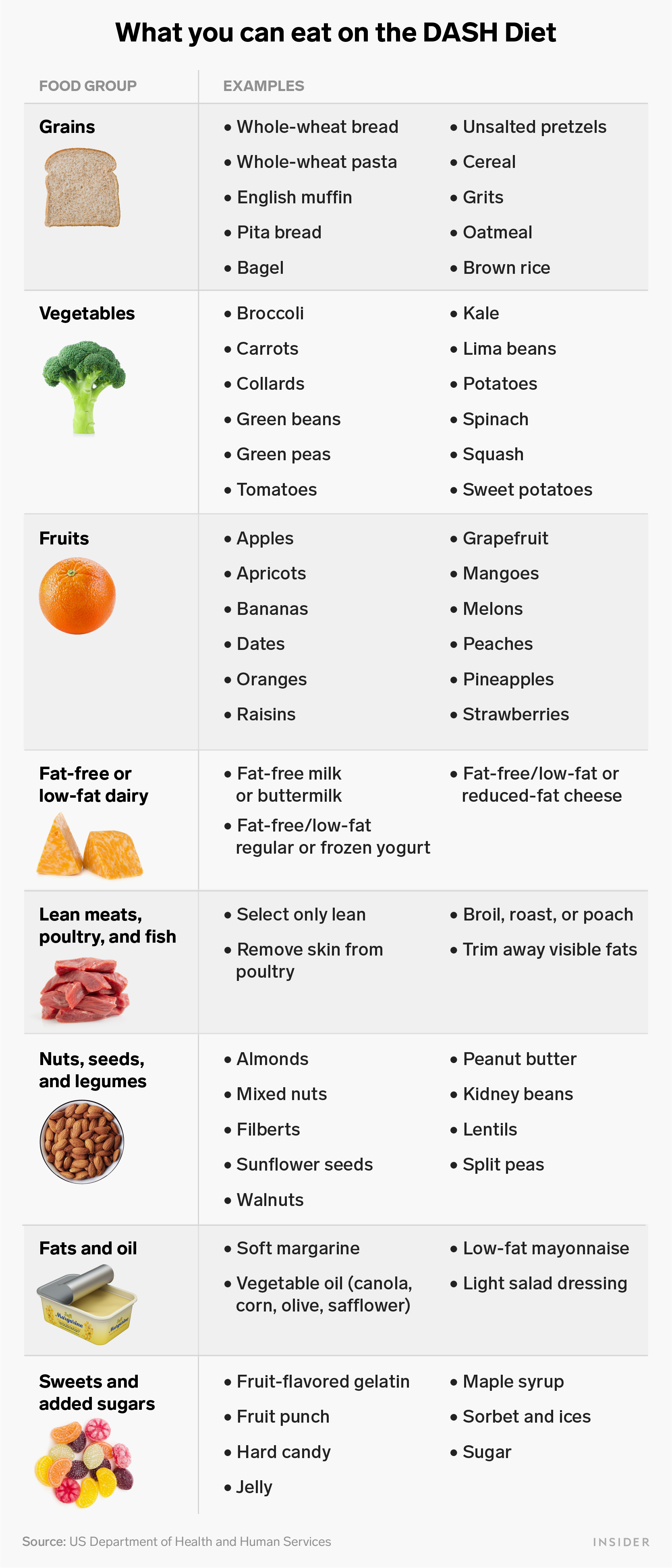
PeopleImages/ Getty Images
- The DASH diet is a highly effective dietary approach aimed to lower blood pressure and prevent heart disease.
- On the DASH diet, you’ll eat foods that are low in sodium and high in potassium, calcium, magnesium, protein, and fiber — such as leafy greens, fruits, whole grains, nuts, low-fat dairy, and lean meats.
- You’ll avoid or limit foods that are high in saturated fat, such as red meat and whole-milk dairy, as well as sugary foods and sweetened beverages.
- This story is a part of Insider’s guide to High Blood Pressure.
The DASH diet, which stands for Dietary Approaches To Stop Hypertension, is exactly what its name implies: An eating plan meant to help lower or control high blood pressure.
Since it’s development in the early 1990s, the DASH diet has been endorsed by the National Institutes of Health (NIH) as an effective way to lower blood pressure and reduce the risk of hypertension and heart disease in people over time.
Today, dietitians say that the DASH diet is one of the healthiest and most sustainable diets. While it is targeted towards people trying to lower their blood pressure, it offers a flexible diet that focuses on the fundamentals of healthy eating – so just about anyone can follow it.
What can you eat on the DASH diet?
At its core, following DASH means a dietary approach that aims to eat a diet rich in:
- Whole-grains
- Vegetables
- Fruits
- Fat-free or low-fat dairy products
- Leans meats, poultry and fish
- Nuts, seeds and legumes
There’s no food group that the DASH diet restricts: All food groups are technically allowed. Instead the DASH diet emphasizes heart-healthy foods and smart portioning and moderating of high-fat foods and salt.
Some examples of DASH-approved foods are oatmeal, leafy greens, potatoes, apples, bananas, oranges, fish, and mixed nuts.

The DASH diet provides a recommended number of daily and weekly servings of these food groups. These loose serving guidelines are what makes the diet sustainable and flexible, allowing each person to pick their own meal plan.
DASH diet recommended daily servings:
- 6-8 servings of grains
- 2-3 servings of dairy
- 4-5 servings of vegetables
- 4-5 servings of fruits
- 6 one-ounce servings of lean protein
DASH diet recommended weekly servings:
- 5 servings or less of sweet foods a week
- 4-5 servings of legumes, nuts, nut butters, and seeds
What should you limit on the DASH diet?
The DASH eating plan encourages followers to choose healthy food sources that help manage blood pressure. In contrast, the eating plan limits:
- Red meat
- Sodium (salt)
- Sweets and added sugars
Since excess sodium intake has been linked to increased blood pressure, monitoring sodium intake is important for the DASH diet. Depending on your health needs, there are two different DASH diet paths you can take when it comes to sodium:
- Standard DASH diet: This version allows for 2,300 mg of sodium a day, which is about 1 teaspoon of table salt a day.
- Low-sodium DASH diet: This path recommends 1,500 mg of sodium daily, equaling to two-thirds of a teaspoon of salt.
"For too long we focused just on cutting down on sodium," says Lisa Sasson, a registered dietitian and clinical professor of nutrition and food studies at New York University. "We now know that including more of the other minerals that are in plant-based foods is very helpful and beneficial."
That's why the DASH diet is built around nutrient-rich foods that are low in sodium, like fruits, vegetables, and whole grains, with an emphasis on moderating foods high in healthy fats like poly- and mono-unsaturated fat.
Specifically, the DASH diet emphasizes eating foods that are high in potassium, magnesium, calcium, and fiber in addition to monitoring sodium levels.
Following this logic, the DASH diet targets the sources of coronary heart disease and high cholesterol by moderating how many high-fat foods your diet contains like eggs and other dairy products.
What the research says
Over the years, there has been a wide range of studies linking lower blood pressure and the DASH diet, underscoring how nutrition has an important impact on your heart health and blood pressure readings.
A 2017 study published in the Journal of the American College of Cardiology examined 412 participants with pre-hypertension or stage one hypertension - and it was clear that consuming less salt had a direct association with lower blood pressure.
The study found that the participants who followed the DASH diet and reduced their sodium intake to 1,150 milligrams per day for 30 days straight saw a greater reduction in their systolic blood pressure than participants who ate a standard American diet.
Moreover, the higher a person's systolic blood pressure was at the start of the study, the greater the improvement they saw from following a low-sodium DASH diet.
For example, people whose original systolic blood pressure was greater than 150 mm Hg saw a decrease of as much as 15.54 mm Hg, whereas people whose original systolic blood pressure was less than 130 mm Hg saw a drop of as much as 2.07 mm Hg.
A 2014 review in the journal Nutrition, Metabolism & Cardiovascular Disease found that the DASH diet was also associated with lower diastolic blood pressure as well as systolic blood pressure.
And while these two studies didn't examine the diet's effect on blood pressure in the long term, a 2014 study published in the American Journal of Hypertension found that a 16-week structured DASH diet was associated with lower systolic blood pressure for the next eight months.
Moreover, a 2018 study published in the British Journal of Nutrition of 1,409 participants over 24 to 28 years found that living by a DASH diet might also improve a person's cardiovascular health, as it was associated with higher levels of HDL cholesterol and lower pulse wave velocity, a measure of a person's arterial health.
Cardiovascular health was even better for people who paired the DASH diet with regular exercise, the study found.
The DASH diet may also help with weight loss
The benefits of this diet extend beyond hypertension and heart health.
"Although the original research was about the benefits of the DASH diet on hypertension, it would be a diet I recommend for everyone," Sasson says.
According to Sasson, it's a diet that's easy to follow, since it isn't very specific and there aren't many restrictions, aside from cutting out excessive sweets - the NIH recommends five servings of sweets a week at most.
"The diet is very safe and sustainable for anybody who's looking to eat healthier," Sasson says. "It's exactly how we would advise all people to eat."
While the main focus of this diet is not weight loss, Sasson says many people do end up losing some weight on the diet, since many of them are eating healthier, less processed foods, and cutting back on snacking.
For example, a 2016 study found that the DASH diet was more effective for weight loss than other low-energy diets, especially for participants who were overweight or obese.
According to Sasson, the DASH diet is also a good way to educate people on what healthy meals look like, especially when so many of us eat on the go and opt for processed foods.
"We should look at it as one of the healthiest ways to eat," she says.
Sample DASH diet menu
If you think you'd like to try the DASH diet, here is what a day on DASH may look like. Remember: This is a very flexible diet that works with your own preferences and makes room for treats. This diet is based on a 2,000 calorie intake, if your goal is weight loss, you may have to adjust the amount of food you eat to reflect height, weight, and activity level.
- Breakfast: Three-quarters of a cup of bran-flakes cereal, with one medium banana and one cup of low-fat milk, paired with a slice of whole-wheat bread and, if you like, one teaspoon of margarine. Wash it all down with a cup of orange juice.
- Snack: One-third of a cup of unsalted almonds.
- Lunch: Three-quarters of a cup of chicken salad, with two slices of whole-wheat bread and a tablespoon of Dijon mustard.
- Snack: A quarter cup of raisins.
- Dinner: Three ounces of roast beef topped with two tablespoons of fat-free gravy with a side of one cup of sauteed green beans and a small baked potato topped with a teaspoon of margarine. If you're not satisfied, add a small apple and one cup of low-fat milk.
- Snack: Half a cup of fat-free fruit yogurt.
- For more meal ideas, the NIH has a week's worth of daily meal plans.
Insider's takeaway
Here's what to remember about the DASH diet if you decide to try it:
Dieticians recommend the DASH diet for anyone looking to lower their blood pressure in a sustainable and flexible way. You should limit sweet treats to about five times a week and limit dairy to two to three servings a day.
If weight loss is one of your goals, consider tacking calories in addition to following the DASH diet's serving guidelines. You can also monitor your sodium intake to further reduce high blood pressure - between 1,500 mg and 2,300 mg is recommended.
Related stories from Health Reference:
- What foods lower blood pressure and make up the DASH diet
- What causes high blood pressure and how to know if you have hypertension
- How to lower cholesterol with the right diet and exercise regimens
- How to calm anxiety in 6 natural ways, on your own
- Can stress make you sick? Yes, mental health affects physical health
